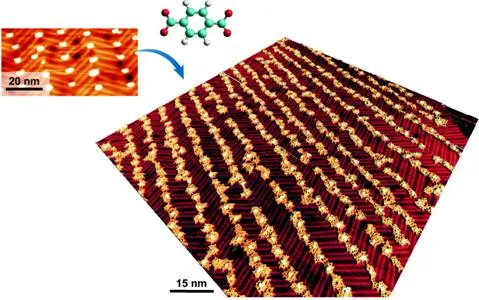2D Coordination Chemistry
Metal-ligand interactions and metal-directed assembly on well-defined substrates
It is appealing to explore coordination-chemistry design principles in 2D. Nevertheless, systematic studies under ultrahigh vacuum were conducted only recently. Of central importance thereby is the simultaneous control of metal centers and molecular species, whose mobility characteristics may differ by orders of magnitude.

Examples for 2D nanoporous metallosupramolecular grids. (a) Rectangular Fe-terephtalate array on Cu(100) with 1,4-benzenedicarboxylic acid tectons and the carboxylate-bridged di-iron center coupling motif overlaid. (b) Density-functional theory (DFT) calculated perspective view of the di-iron unit. The Fe-charge rearrangement contour levels indicated on the right, drawn with respect to a removed iron atom, are ±0.004 e/Å3, whereby the colors indicate increased (magenta) and decreased (blue) electron density, respectively. (c) The DFT-based scanning tunneling microscopy (STM) image simulation agrees with the experimental data. (d) Co-terephthalate nanogrid realized on the quasihexagonal Au(111) substrate. (e) Co-directed assembly of a metal-organic honeycomb lattice on Ag(111) with ≈22 Å cavities. (f) Each mononuclear cobalt center coordinates three cyano ligands of ditopic terphenyl-dicarbonitrile tectons. Adapted from Annu. Rev. Phys. Chem. 58 (2007) 375.
Approaches need to be developed for the synthesis and embedding of nanostructures across multiple length scales. To this end we successfully employed nanotextured substrates that can be processed by tuning and spatially confining coordination reactions with functional molecular species. Methodologies that use such hierarchic assembly protocols are conceivable for a great variety of systems and can be applied at substrates with different symmetries, physical, and chemical properties.

Combination of nanopatterning and controlled metal-organic assembly to process prestructured metallic templates. Following self-organized growth of Fe nanoarrays on the reconstructed Au(111) surface (upper left), mesoscopic organization of metallosupramolecular Fe-terephthalate ribbons is achieved by controlling the reaction conditions. Adapted from Angew. Chem. Int. Ed. 44 (2005) 7294.
Key Papers:
J.V. Barth, Annu. Rev. Phys. Chem. 58,375 (2007) { pdf}
A.P. Seitsonen, M. Lingenfelder, H. Spillmann, A. Dmitriev, S. Stepanow, N. Lin, K. Kern and J.V. Barth, J. Am. Chem. Soc. 128, 5634 (2006)
S. Clair, S. Pons, H. Brune, K. Kern, and J.V. Barth, Angew. Chem. Int. Ed. 44, 7294-7297 (2005)
S. Stepanow, M. Lingenfelder, A. Dmitriev, H. Spillmann, N. Lin, Ch. Cai, J.V. Barth and K. Kern, Nature Mat. 3, 229 (2004) {pdf}
A. Dmitriev, H. Spillmann, N. Lin, J.V. Barth and K. Kern, Angew. Chem. Int. Ed. 42, 2670 (2003).